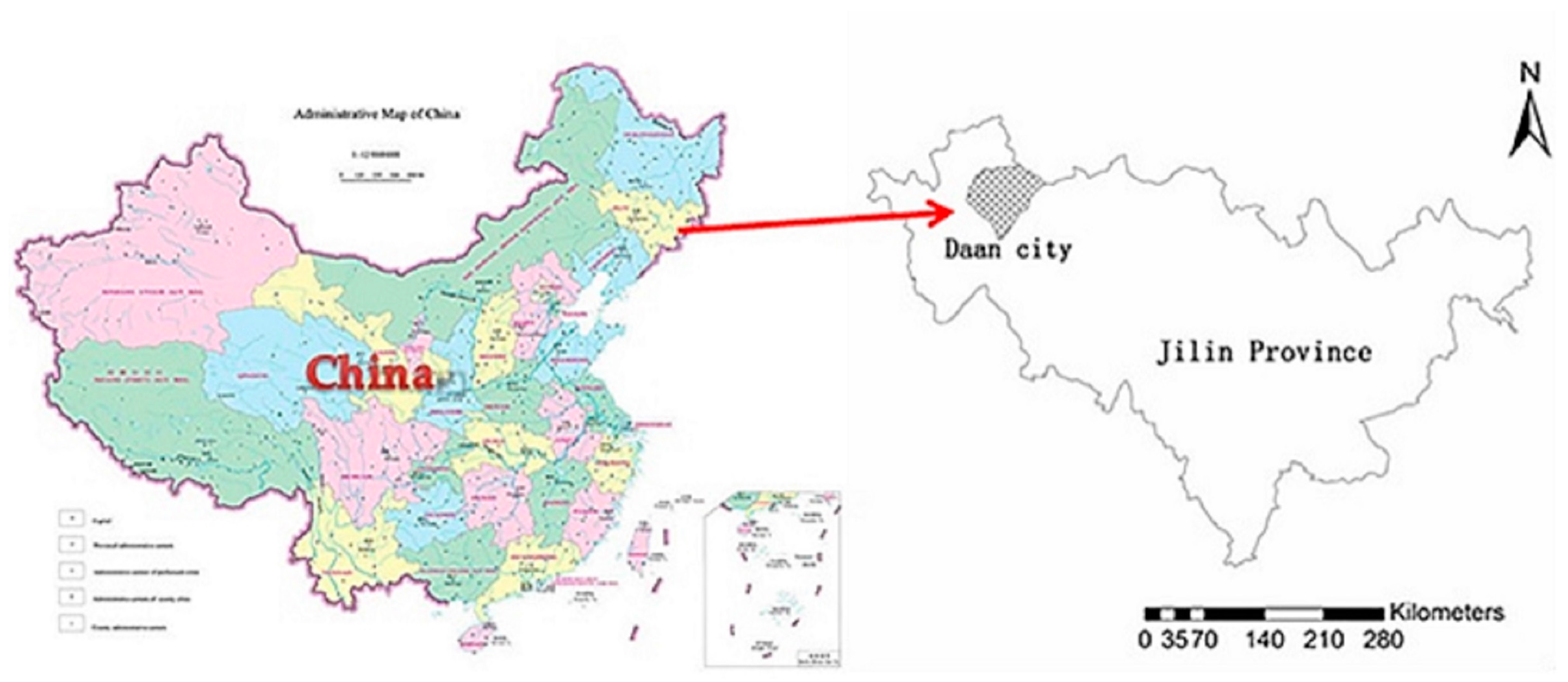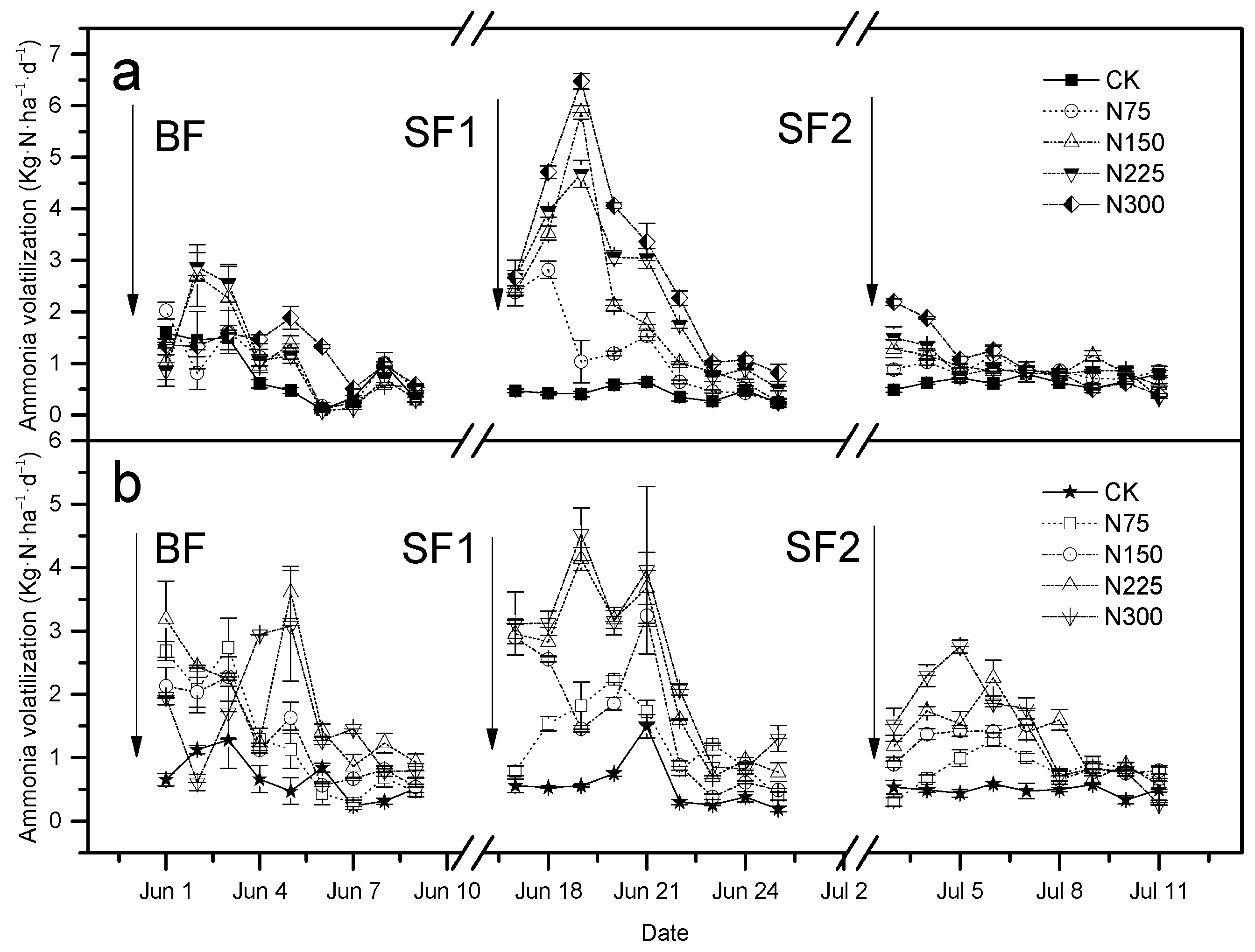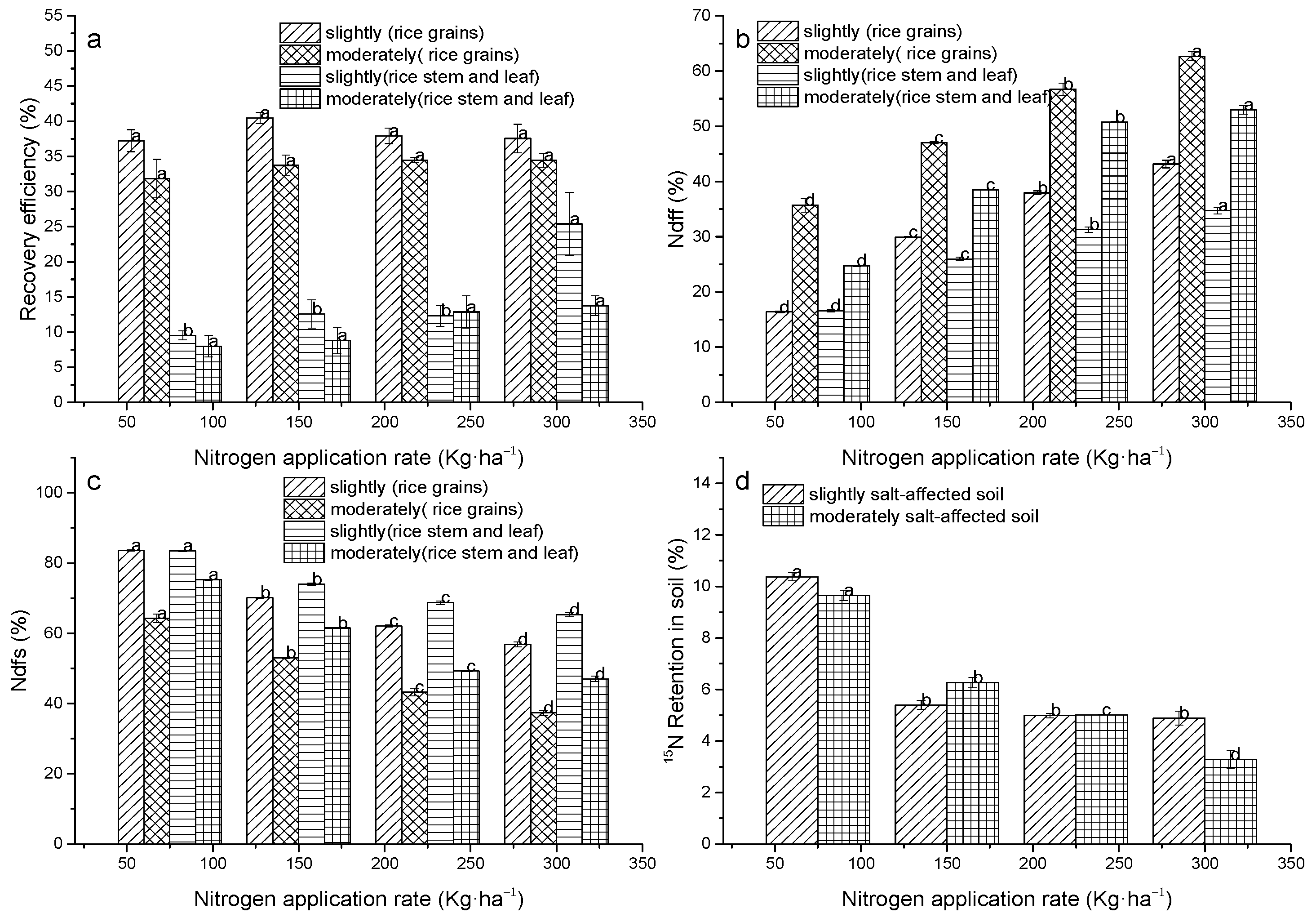Assessment of Ammonia Volatilization Losses and Nitrogen Utilization during the Rice Growing Season in Alkaline Salt-Affected Soils
Abstract
:1. Introduction
2. Materials and Methods
2.1. Experimental Site Description
2.2. Experiment Design
2.3. Measurement of Soil Ammonia Volatilization
2.4. Nitrogen Analysis
2.5. Data Analysis
3. Results
3.1. Simulation Experiments to Quantify Ammonia Volatilization
3.2. Rice Nitrogen Migration and NUE
3.2.1. Pot Experiment to Quantify Ammonia Volatilization
3.2.2. Nitrogen Absorption and Distribution in Rice Plants
4. Discussion
4.1. Ammonia Volatilization, Nitrogen Absorption, and Distribution by Rice
4.2. Fair Balance among N Fertilizer Level, Ammonia Volatilization, and Productivity
5. Conclusions
Acknowledgments
Author Contributions
Conflicts of Interest
References
- Sutton, M.A.; Oenema, O.; Erisman, J.W.; Leip, A.; van Grinsven, H.; Winiwarter, W. Too much of a good thing. Nature 2011, 472, 159–161. [Google Scholar] [CrossRef] [PubMed]
- Vitousek, P.M.; Naylor, R.; Crews, T.; David, M.B.; Drinkwater, L.E.; Holland, E.; Johnes, P.J.; Katzenberger, J.; Martinelli, L.A.; Matson, P.A.; et al. Agriculture. Nutrient imbalances in agricultural development. Science 2009, 324, 1519–1520. [Google Scholar] [CrossRef] [PubMed]
- Cassman, K.G.; Dobermann, A.; Walters, D.T.; Yang, H. Meeting cereal demand while protecting natural resources and improving environmental quality. Annu. Rev. Environ. Resour. 2003, 28, 315–358. [Google Scholar] [CrossRef]
- Godinot, O.; Carof, M.; Vertès, F.; Leterme, P. Syne: An improved indicator to assess nitrogen efficiency of farming systems. Agric. Syst. 2014, 127, 41–52. [Google Scholar] [CrossRef]
- Duan, Y.; Xu, M.; Gao, S.; Yang, X.; Huang, S.; Liu, H.; Wang, B. Nitrogen use efficiency in a wheat–corn cropping system from 15 years of manure and fertilizer applications. Field Crops Res. 2014, 157, 47–56. [Google Scholar] [CrossRef]
- Salazar, F.; Martínez-Lagos, J.; Alfaro, M.; Misselbrook, T. Ammonia emissions from urea application to permanent pasture on a volcanic soil. Atmos. Environ. 2012, 61, 395–399. [Google Scholar] [CrossRef]
- Ni, K.; Pacholski, A.; Kage, H. Ammonia volatilization after application of urea to winter wheat over 3 years affected by novel urease and nitrification inhibitors. Agric. Ecosyst. Environ. 2014, 197, 184–194. [Google Scholar] [CrossRef]
- Xing, G.; Zhu, Z. An assessment of n loss from agricultural fields to the environment in china. Nutr. Cycl. Agroecosyst. 2000, 57, 67–73. [Google Scholar] [CrossRef]
- Zhu, Z.; Chen, D. Nitrogen fertilizer use in China—Contributions to food production, impacts on the environment and best management strategies. Nutr. Cycl. Agroecosyst. 2002, 63, 117–127. [Google Scholar] [CrossRef]
- Rochette, P.; Angers, D.A.; Chantigny, M.H.; MacDonald, J.D.; Bissonnette, N.; Bertrand, N. Ammonia volatilization following surface application of urea to tilled and no-till soils: A laboratory comparison. Soil Tillage Res. 2009, 103, 310–315. [Google Scholar] [CrossRef]
- Xu, J.; Liao, L.; Tan, J.; Shao, X. Ammonia volatilization in gemmiparous and early seedling stages from direct seeding rice fields with different nitrogen management strategies: A pots experiment. Soil Tillage Res. 2013, 126, 169–176. [Google Scholar] [CrossRef]
- Zhang, Y.; Luan, S.; Chen, L.; Shao, M. Estimating the volatilization of ammonia from synthetic nitrogenous fertilizers used in china. J. Environ. Manag. 2011, 92, 480–493. [Google Scholar] [CrossRef] [PubMed]
- Fillery, I.R.P.; Vlek, P.L.G. Reappraisal of the significance of ammonia volatilization as an N loss mechanism in flooded rice fields. In Nitrogen Economy of Flooded Rice Soils: Proceedings of a Symposium on the Nitrogen Economy of Flooded Rice Soils, Washington, DC, 1983; Datta, S.K., Patrick, W.H., Eds.; Springer: Dordrecht, The Netherlands, 1986; pp. 79–98. [Google Scholar]
- Sommer, S.G.; Schjoerring, J.K.; Denmead, O. Ammonia emission from mineral fertilizers and fertilized crops. Adv. Agron. 2004, 82, 557–622. [Google Scholar]
- Cao, Y.; Tian, Y.; Yin, B.; Zhu, Z. Assessment of ammonia volatilization from paddy fields under crop management practices aimed to increase grain yield and n efficiency. Field Crops Res. 2013, 147, 23–31. [Google Scholar] [CrossRef]
- Salazar, F.; Martínez-Lagos, J.; Alfaro, M.; Misselbrook, T. Ammonia emission from a permanent grassland on volcanic soil after the treatment with dairy slurry and urea. Atmos. Environ. 2014, 95, 591–597. [Google Scholar] [CrossRef]
- Chen, G.; Chen, Y.; Zhao, G.; Cheng, W.; Guo, S.; Zhang, H.; Shi, W. Do high nitrogen use efficiency rice cultivars reduce nitrogen losses from paddy fields? Agric. Ecosyst. Environ. 2015, 209, 26–33. [Google Scholar] [CrossRef]
- Liu, T.Q.; Fan, D.J.; Zhang, X.X.; Chen, J.; Li, C.F.; Cao, C.G. Deep placement of nitrogen fertilizers reduces ammonia volatilization and increases nitrogen utilization efficiency in no-tillage paddy fields in central china. Field Crops Res. 2015, 184, 80–90. [Google Scholar] [CrossRef]
- Sun, H.; Zhang, H.; Powlson, D.; Min, J.; Shi, W. Rice production, nitrous oxide emission and ammonia volatilization as impacted by the nitrification inhibitor 2-chloro-6-(trichloromethyl)-pyridine. Field Crops Res. 2015, 173, 1–7. [Google Scholar] [CrossRef]
- Kissel, D.; Brewer, H.; Arkin, G. Design and test of a field sampler for ammonia volatilization. Soil Sci. Soc. Am. J. 1977, 41, 1133–1138. [Google Scholar] [CrossRef]
- Shoji, T.; Nakamura, E. Collection of indonaphthol blue on a membrane filter for the spectrophotometric determination of ammonia with 1-naphthol and dichloroisocyanurate. Anal. Sci. 2010, 26, 779–783. [Google Scholar] [CrossRef] [PubMed]
- Hauck, R.; Bremner, J. Use of tracers for soil and fertilizer nitrogen research. Adv. Agron. 1976, 28, 219–266. [Google Scholar]
- Mandal, S.; Thangarajan, R.; Bolan, N.S.; Sarkar, B.; Khan, N.; Ok, Y.S.; Naidu, R. Biochar-induced concomitant decrease in ammonia volatilization and increase in nitrogen use efficiency by wheat. Chemosphere. 2016, 142, 120–127. [Google Scholar] [CrossRef] [PubMed]
- Lin, Z.-C.; Dai, Q.-G.; Ye, S.-C.; Wu, F.-G.; Jia, Y.-S.; Chen, J.-D.; Xu, L.-S.; Zhang, H.-C.; Huo, Z.-Y.; Xu, K.; et al. Effects of nitrogen application levels on ammonia volatilization and nitrogen utilization during rice growing season. Rice Sci. 2012, 19, 125–134. [Google Scholar] [CrossRef]
- Soares, J.R.; Cantarella, H.; Menegale, M.L.D.C. Ammonia volatilization losses from surface-applied urea with urease and nitrification inhibitors. Soil Biol. Biochem. 2012, 52, 82–89. [Google Scholar] [CrossRef]
- Xinqiang, L.; Junli, Y.; Miaomiao, H.; Hua, L.; Liang, L.; Guangming, T. Modeling the fate of fertilizer N in paddy rice systems receiving manure and urea. Geoderma 2014, 228–229, 54–61. [Google Scholar] [CrossRef]
- Zhang, Q.; Yang, Z.; Zhang, H.; Yi, J. Recovery efficiency and loss of 15N-labelled urea in a rice–soil system in the upper reaches of the yellow river basin. Agric. Ecosyst. Environ. 2012, 158, 118–126. [Google Scholar] [CrossRef]
- Hashim, M.M.A.; Yusop, M.K.; Othman, R.; Wahid, S.A. Characterization of nitrogen uptake pattern in malaysian rice MR219 at different growth stages using 15N isotope. Rice Sci. 2015, 22, 250–254. [Google Scholar] [CrossRef]
- Xu, H.; Zhong, G.; Lin, J.; Ding, Y.; Li, G.; Wang, S.; Liu, Z.; Tang, S.; Ding, C. Effect of nitrogen management during the panicle stage in rice on the nitrogen utilization of rice and succeeding wheat crops. Eur. J. Agron. 2015, 70, 41–47. [Google Scholar] [CrossRef]
- Linquist, B.A.; Liu, L.; van Kessel, C.; van Groenigen, K.J. Enhanced efficiency nitrogen fertilizers for rice systems: Meta-analysis of yield and nitrogen uptake. Field Crops Res. 2013, 154, 246–254. [Google Scholar] [CrossRef]
- Duan, Y.-H.; Shi, X.-J.; Li, S.-L.; Sun, X.-F.; He, X.-H. Nitrogen use efficiency as affected by phosphorus and potassium in long-term rice and wheat experiments. J. Integr. Agric. 2014, 13, 588–596. [Google Scholar] [CrossRef]
- Ahmed, S.; Humphreys, E.; Salim, M.; Chauhan, B.S. Growth, yield and nitrogen use efficiency of dry-seeded rice as influenced by nitrogen and seed rates in bangladesh. Field Crops Res. 2016, 186, 18–31. [Google Scholar] [CrossRef]
- Chen, Z.C.; Ma, J.F. Improving nitrogen use efficiency in rice through enhancing root nitrate uptake mediated by a nitrate transporter, NRT1.1B. J. Genet. Genom. 2015, 42, 463–465. [Google Scholar] [CrossRef] [PubMed]
- Sui, B.; Feng, X.; Tian, G.; Hu, X.; Shen, Q.; Guo, S. Optimizing nitrogen supply increases rice yield and nitrogen use efficiency by regulating yield formation factors. Field Crops Res. 2013, 150, 99–107. [Google Scholar] [CrossRef]
- Che, S.-G.; Zhao, B.-Q.; Li, Y.-T.; Yuan, L.; Li, W.; Lin, Z.-A.; Hu, S.-W.; Shen, B. Review grain yield and nitrogen use efficiency in rice production regions in china. J. Integr. Agric. 2015, 14, 2456–2466. [Google Scholar] [CrossRef]





| pH | EC (μS/cm) | NaCl (mL) | Na2CO3 (mL) a | NaHCO3 (mL) a |
|---|---|---|---|---|
| 7.59 | 700 | 0.75 | 0.05 | 0 |
| 7.85 | 700 | 0.75 | 0.10 | 0 |
| 8.30 | 700 | 0.70 | 0 | 0.15 |
| 8.55 | 700 | 0.35 | 0 | 0.45 |
| 9.05 | 700 | 0.75 | 0.15 | 0 |
| 9.58 | 700 | 0.75 | 0.25 | 0 |
| pH | EC (μS/cm) | NaCl (mL) a | Na2CO3 (mL) a | NaHCO3 (mL) |
|---|---|---|---|---|
| 8.55 | 250 | 0 | 0 | 0.35 |
| 8.55 | 528 | 0 | 0 | 0.75 |
| 8.55 | 754 | 0.50 | 0 | 0.50 |
| 8.55 | 934 | 0.50 | 0 | 0.75 |
| 8.55 | 1137 | 0.75 | 0 | 0.75 |
| 8.55 | 1415 | 1.00 | 0 | 0.75 |
| 8.55 | 1736 | 1.50 | 0 | 0.75 |
| Fertilizers | Days | Control Factors | ||
|---|---|---|---|---|
| pH | EC (μS/cm) | Fertilizer Amount (kg/ha) | ||
| (U/AN/AS) | 5 | 7.59 | 700 | 200 |
| 5 | 7.85 | 700 | 200 | |
| 5 | 8.30 | 700 | 200 | |
| 5 | 8.55 | 700 | 200 | |
| 5 | 9.05 | 700 | 200 | |
| 5 | 9.58 | 700 | 200 | |
| Fertilizers | Days | Control Factors | ||
|---|---|---|---|---|
| pH | EC (μS/cm) | Fertilizer Amount (kg/ha) | ||
| (U/AN/AS) | 5 | 8.55 | 250 | 200 |
| 5 | 8.55 | 528 | 200 | |
| 5 | 8.55 | 754 | 200 | |
| 5 | 8.55 | 934 | 200 | |
| 5 | 8.55 | 1137 | 200 | |
| 5 | 8.55 | 1415 | 200 | |
| 5 | 8.55 | 1736 | 200 | |
| Items | Soil Type | |
|---|---|---|
| Slightly Salt-Affected Soil | Moderately Salt-Affected Soil | |
| Organic matter (g/kg) | 19.24 ± 0.46 | 13.04 ± 0.59 |
| Total nitrogen (g/kg) | 2.38 ± 0.31 | 1.48 ± 0.20 |
| Available nitrogen (mg/kg) | 82.31 ± 4.21 | 67.52 ± 3.76 |
| Available phosphorus(mg/kg) | 39.44 ± 2.62 | 33.62 ± 1.38 |
| Available potassium(mg/kg) | 355.2 ± 8.44 | 320.4 ± 6.30 |
| EC(μS/cm) | 354 ± 37.81 | 374 ± 54.94 |
| pH | 7.91 ± 0.12 | 8.39 ± 0.23 |
| Management Practices | Alkaline Salt-Affected Soils | ||
|---|---|---|---|
| BF (kg·N/ha) at the Regreening Stage | SF1 (kg·N/ha) at the Tillering Stage | SF2 (kg·N/ha) at the Booting Stage | |
| CK | 0 | 0 | 0 |
| N75 | 37.5 | 22.5 | 15.0 |
| N150 | 75.0 | 45.0 | 30.0 |
| N225 | 112.5 | 67.5 | 45.0 |
| N300 | 150.0 | 90.0 | 60.0 |
| Soil | Code | BF | SF1 | SF2 | Seasonal Ammonia Losses | ||||
|---|---|---|---|---|---|---|---|---|---|
| Amount (kg·N/ha) | Seasonal Losses (%) | Amount (kg·N/ha) | Seasonal Losses (%) | Amount (kg·N/ha) | Seasonal Losses (%) | Amount (kg·N/ha) | Total Inputs (%) | ||
| Light | CK | 7.65c | 44.5 | 3.84e | 22.4 | 5.69d | 33.1 | 17.18 | - |
| N75 | 8.90bc | 33.1 | 10.73d | 40.0 | 7.22c | 26.9 | 26.85 | 35.8 | |
| N150 | 10.02ab | 27.3 | 18.39c | 50.1 | 8.31b | 22.6 | 36.72 | 24.5 | |
| N225 | 10.03ab | 25.6 | 21.28b | 54.3 | 7.86bc | 20.1 | 39.17 | 17.4 | |
| N300 | 11.43a | 23.9 | 26.45a | 55.3 | 9.94a | 20.8 | 47.82 | 15.9 | |
| Moderate | CK | 6.55c | 41.2 | 5.04c | 31.7 | 4.32d | 27.2 | 15.91 | - |
| N75 | 11.75b | 38.4 | 11.30b | 36.9 | 7.57c | 24.7 | 30.62 | 40.8 | |
| N150 | 11.23b | 32.1 | 14.38b | 41.1 | 9.34b | 26.7 | 34.95 | 23.3 | |
| N225 | 15.42a | 31.9 | 20.82a | 43.1 | 12.09a | 25.0 | 48.33 | 21.5 | |
| N300 | 15.27a | 30.4 | 22.95a | 45.7 | 11.95a | 23.8 | 50.17 | 16.7 | |
| Soil | Treatments | Grains (g) | Increase Yield Relative to CK (%) | Crops and Soil Recovery Efficiency (%) | Nitrogen Apparent Loss Rate (%) | Physiological Efficiency (N·kg/kg) | Nitrogen Agronomic Efficiency (N·kg/kg) |
|---|---|---|---|---|---|---|---|
| Lightly | CK | 81.25c | - | - | - | - | - |
| N75 | 99.75b | 22.8 | 57.1b | 42.9a | 35.9ab | 3.8b | |
| N150 | 101.25b | 24.6 | 58.5b | 43.1a | 31.3b | 6.4ab | |
| N225 | 115.75ab | 42.5 | 55.2b | 44.8a | 55.8a | 8.0a | |
| N300 | 121.25a | 49.2 | 67.8a | 32.2b | 50.7ab | 6.9ab | |
| Moderately | CK | 38.25e | - | - | - | - | - |
| N75 | 45.75d | 19.6 | 49.5a | 50.5a | 24.8b | 5.2b | |
| N150 | 59.25c | 54.9 | 48.8a | 51.2a | 43.9ab | 7.3a | |
| N225 | 72.25b | 88.9 | 52.4a | 47.7a | 50.5a | 7.9a | |
| N300 | 87.25a | 128.1 | 51.5a | 48.5a | 48.1a | 8.5a |
| Soil | Treatments | GY-CK (g) | GY-T (g) | AV-CK (kg·N/ha) | AV-T (kg·N/ha) |
|---|---|---|---|---|---|
| Lightly | CK | 0 | 0 | ||
| N75 | 18.5 | 18.5 | 9.67 | 9.67 | |
| N150 | 20 | 1.5 | 19.54 | 9.87 | |
| N225 | 34.5 | 14.5 | 21.99 | 2.45 | |
| N300 | 40 | 5.5 | 30.64 | 8.65 | |
| moderately | CK | 0 | 0 | ||
| N75 | 7.5 | 7.5 | 14.71 | 14.71 | |
| N150 | 21 | 13.5 | 19.04 | 4.33 | |
| N225 | 34 | 13 | 32.42 | 13.38 | |
| N300 | 49 | 15 | 34.26 | 1.84 |
© 2017 by the authors; licensee MDPI, Basel, Switzerland. This article is an open access article distributed under the terms and conditions of the Creative Commons Attribution (CC-BY) license (http://creativecommons.org/licenses/by/4.0/).
Share and Cite
Li, Y.; Huang, L.; Zhang, H.; Wang, M.; Liang, Z. Assessment of Ammonia Volatilization Losses and Nitrogen Utilization during the Rice Growing Season in Alkaline Salt-Affected Soils. Sustainability 2017, 9, 132. https://doi.org/10.3390/su9010132
Li Y, Huang L, Zhang H, Wang M, Liang Z. Assessment of Ammonia Volatilization Losses and Nitrogen Utilization during the Rice Growing Season in Alkaline Salt-Affected Soils. Sustainability. 2017; 9(1):132. https://doi.org/10.3390/su9010132
Chicago/Turabian StyleLi, Yangyang, Lihua Huang, Huan Zhang, Mingming Wang, and Zhengwei Liang. 2017. "Assessment of Ammonia Volatilization Losses and Nitrogen Utilization during the Rice Growing Season in Alkaline Salt-Affected Soils" Sustainability 9, no. 1: 132. https://doi.org/10.3390/su9010132





